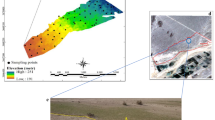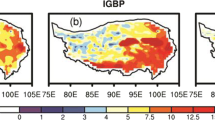Abstract
Purpose
Integrating process-based models with machine learning (ML) is an important way to derive spatially-explicit information on the dynamics of cropland soil organic carbon (SOC) stock. However, the performance of integrating process-based models with different structures remains unclear. The purpose of this study is to develop integrated models by combining multiple process-based models with ML for improving the spatiotemporal dynamics modelling of cropland SOC.
Methods
A total of 1219 cropland SOC stock data (0–20 cm, sampled in 1980, 2000, and 2015) were collected from southern Jiangsu Province of China. Three models were built by integrating either Rothamsted carbon model (RothC), microbial-mineral carbon stabilization model (MIMICS), or the both with space-for-time random forest (RF-SFTS).
Results
The overall spatiotemporal patterns of SOC dynamics that modelled by RothC, MIMICS, the integration of RothC with RF-SFTS (RF-RothC), the integration of MIMICS with RF-SFTS (RF-MIMICS), and the integration of RothC and MIMICS with RF-SFTS (RF-RothC-MIMICS) were similar, but their prediction accuracies differed significantly. The RF-RothC-MIMICS model had the best performance among the six models, being a lowest root mean squared error (RMSE) of 0.79 kg C m−2 and a highest coefficient of determination (R2) of 0.54, compared to the prediction accuracy of other models.
Conclusions
Integrating process-based models differing in structures with ML significantly improved the spatiotemporal modelling of SOC dynamics. Outputs of this study may provide some guidance on more realistic projection of SOC dynamics under future changes in climate, land use, and management practices.







Similar content being viewed by others
Data availability
The datasets analysed during the current study are available from the corresponding author on reasonable request.
References
Adhikari K, Mishra U, Owens PR, Libohova Z, Wills SA, Riley WJ, Hoffman FM, Smith DR (2020) Importance and strength of environmental controllers of soil organic carbon changes with scale. Geoderma 375:114472. https://doi.org/10.1016/j.geoderma.2020.114472
Adhikari K, Owens PR, Libohova Z, Miller DM, Wills SA, Nemecek J (2019) Assessing soil organic carbon stock of Wisconsin, USA and its fate under future land use and climate change. Sci Total Environ 667:833–845. https://doi.org/10.1016/j.scitotenv.2019.02.420
Chen SC, Arrouays D, Angers DA, Chenu C, Barre P, Martin MP, Saby NPA, Walter C (2019) National estimation of soil organic carbon storage potential for arable soils: a data-driven approach coupled with carbon-landscape zones. Sci Total Environ 666:355–367. https://doi.org/10.1016/j.scitotenv.2019.02.249
Choudhury SG, Sivastava S, Singh R, Chaudhari SK, Sharma DK, Singh SK, Sarkar D (2014) Tillage and residue management effects on soil aggregation, organic carbon dynamics and yield attribute in rice-wheat cropping system under reclaimed sodic soil. Soil Tillage Res 136:76–83. https://doi.org/10.1016/j.still.2013.10.001
Dechow R, Franko U, Kätterer T, Kolbe H (2019) Evaluation of the RothC model as a prognostic tool for the prediction of SOC trend in response to management practices on arable land. Geoderma 337:463–478. https://doi.org/10.1016/j.geoderma.2018.10.001
Doetterl S, Stevens A, Six J, Merckx R, Oost KV, Pinto MC, Casanova-Katny A, Muñoz C, Boudin M, Venegas EZ, Boeckx P (2015) Soil carbon storage controlled by interactions between geochemistry and climate. Nature Geosci 8:780–783. https://doi.org/10.1038/ngeo2516
Fang JY, Yu GR, Liu LL, Hu SJ, Chapin Iii FS (2018) Climate change, human impacts, and carbon sequestration in China. Proc Natl Acad Sci USA 115(16):4015–4020. https://doi.org/10.1073/pnas.1700304115
Georgiou K, Abramoff RZ, Harte J, Riley WJ, Torn MS (2017) Microbial community-level regulation explains soil carbon responses to long-term litter manipulations. Nat Commun 8:1223. https://doi.org/10.1038/s41467-017-01116-z
Guo ZX, Adhikari K, Chellasamy M, Greve MB, Owens PR, Greve MH (2019) Selection of terrain attributes and its scale dependency on soil organic carbon prediction. Geoderma 340:303–312. https://doi.org/10.1016/j.geoderma.2019.01.023
Hamzehpour N, Shafizadeh-Moghadam, H, Valavi R (2019) Exploring the driving forces and digital mapping of soil organic carbon using remote sensing and soil texture. Catena 182:104141. https://doi.org/10.1016/j.catena.2019.104141
Hararuk O, Smith MJ, Luo YQ (2015) Microbial models with data-driven parameters predict stronger soil carbon responses to climate change. Glob Change Biol 21(6):2439–2453. https://doi.org/10.1111/gcb.12827
Hendriks CMJ, Stoorvogel JJ, Alvarez-Martínez JM, Claessens L, Perez-Silos I, Barquín J (2020) Introducing a mechanistic model in digital soil mapping to predict soil organic matter stocks in the Cantabrian region (Spain). Eur J Soil Sci. https://doi.org/10.1111/ejss.13011
Heuvelink GBM, Angelini ME, Poggio L, Bai ZG, Batjes NH, Bosch R, Bossio D, Estella S, Lehmann J, Olmedo GF, Sanderman J (2020) Machine learning in space and time for modelling soil organic carbon change. Eur J Soil Sci 72(4):1607–1623. https://doi.org/10.1111/ejss.12998
ISSCAS (1978) Soil physics and chemistry analysis. Shanghai Science & Technology Press, Shanghai
Jenkinson DS (1990) The turnover of organic carbon and nitrogen in soil. Philos Trans R Soc Lond B Biol Sci 329:361–368. https://doi.org/10.1098/rstb.1990.0177
Jiang GY, Shirato Y, Xu MG, Yagasaki Y, Huang QH, Li ZZ, Nie J, Shi XJ (2013) Testing the modified Rothamsted carbon model for paddy soils against the results from long- term experiments in southern China. Soil Sci Plant Nutr 59(1):16–26. https://doi.org/10.1080/00380768.2012.733923
Lal R (2004) Soil carbon sequestration impacts on global climate change and food security. Science 304(5677):1623–1627. https://doi.org/10.1126/science.1097396
Lal R (2014) Societal value of soil carbon. J Soil Water Conserv 69(6):186A–192A. https://doi.org/10.2489/jswc.69.6.186A
Lal R (2016) Soil health and carbon management. Food Energy Secur 5(4):212–222. https://doi.org/10.1002/fes3.96
Li JW, Wang GS, Allison SD, Mayes MA, Luo YQ (2014) Soil carbon sensitivity to temperature and carbon use efficiency compared across microbial-ecosystem models of varying complexity. Biogeochemistry 119:67–84. https://doi.org/10.1007/s10533-013-9948-8
Luo YQ, Ahlström A, Allison SD, Batjes NH, Brovkin V, Carvalhais N, Chappell A, Ciais P, Davidson EA, Finzi A, Georgiou K, Guenet B, Hararuk O, Harden JW, He YJ, Hopkins F, Jiang LF, Koven C, Jackson RB, Jones CD, Lara MJ, Liang JY, McGuire AD, Parton W, Peng CH, Randerson JT, Salazar A, Sierra CA, Smith MJ, Tian HQ, Todd-Brown KEO, Torn M, van Groenigen KJ, Wang YP, West TO, Wei YX, Xia WWR, JX, Xu X, Xu XF, Zhou T (2016) Toward more realistic projections of soil carbon dynamics by Earth system models. Global Biogeochem Cycles 30(1):40–56. https://doi.org/10.1002/2015gb005239
Luo ZK, Feng WT, Luo YQ, Baldock J, Wang EL (2017) Soil organic carbon dynamics jointly controlled by climate, carbon inputs, soil properties and soil carbon fractions. Glob Change Biol 23:4430–4439. https://doi.org/10.1111/gcb.13767
Luo ZK, Viscarra Rossel RA, Shi Z (2020) Distinct controls over the temporal dynamics of soil carbon fractions after land use change. Glob Change Biol 26(8):4614–4625. https://doi.org/10.1111/gcb.15157
Mehler K, Schoning I, Berli M (2014) The importance of rock fragment density for the calculation of soil bulk density and soil organic carbon stocks. Soil Sci Soc Am J 78(4):1186–1191. https://doi.org/10.2136/sssaj2013.11.0480
Minasny B, McBratney AB, Malone BP, Wheeler I (2013) Digital mapping of soil carbon. Adv Agron 118:1–47. https://doi.org/10.1016/b978-0-12-405942-9.00001-3
Mishra U, Gautam S, Riley WJ, Hoffman FM (2020) Ensemble machine learning approach improves predicted spatial variation of surface soil organic carbon stocks in data-limited northern circumpolar region. Front Big Data 3:528441. https://doi.org/10.3389/fdata.2020.528441
Mishra U, Riley WJ (2015) Scaling impacts on environmental controls and spatial heterogeneity of soil organic carbon stocks. Biogeosciences 12:3993–4004. https://doi.org/10.5194/bg-12-3993-2015
Ogle SM, Breidt FJ, Easter M, Williams S, Killian K, Paustian K (2010) Scale and uncertainty in modeled soil organic carbon stock changes for US croplands using a process-based model. Glob Change Biol 16(2):810–822. https://doi.org/10.1111/j.1365-2486.2009.01951.x
Olson KR, Al-Kaisi M, Lal R, Cihacek L (2016) Impact of soil erosion on soil organic carbon stocks. J Soil Water Conserv 71:61A-67A. https://doi.org/10.2489/jswc.71.3.61A
Sanderman J, Hengl T, Fiske GJ (2017) Soil carbon debt of 12,000 years of human land use. Proc Natl Acad Sci USA 114(36):9575–9580. https://doi.org/10.1073/pnas.1706103114
Shi Z, Crowell S, Luo Y, Moore III B (2018) Model structures amplify uncertainty in predicted soil carbon responses to climate change. Nat Commun 9:2171. https://doi.org/10.1038/s41467-018-04526-9
Shirato Y, Yokozawa M (2005) Applying the Rothamsted carbon model for long-term experiments on Japanese paddy soils and modifying it by simple tuning of the decomposition rate. J Soil Sci Plant Nut 51:405–415. https://doi.org/10.1111/j.1747-0765.2005.tb00046.x
Smith P, Smith J, Wattenbach M, Meyer J, Lindner M, Zaehle S, Hiederer R, Jones RJA, Montanarella L, Rounsevell M, Reginster I, Kankaanpää S (2006) Projected changes in mineral soil carbon of European forests, 1990–2100. Can J Soil Sci 86:159–169. https://doi.org/10.4141/S05-078
Song GH, Pan GX, Zhang Q (2005) Topsoil SOC storage of China agricultural soils and its loss by cultivation. Biogeochemistry 74(1):47–62. https://doi.org/10.1007/s10533-004-2222-3
Wadoux AMJ-C, Minasny B, McBratney AB (2020) Machine learning for digital soil mapping: applications, challenges and suggested solutions. Earth Sci Rev 210C:103359. https://doi.org/10.31223/osf.Io/8eq6s
Wadoux AMJ-C, Brus, DJ, Heuvelink GBM (2019) Sampling design optimization for soil mapping with random forest. Geoderma 355:113913. https://doi.org/10.1016/j.geoderma.2019.113913
Wang GC, Zhang W, Sun WJ, Li TT, Han PF (2017) Modeling soil organic carbon dynamics and their driving factors in the main global cereal cropping systems. Atmos Chem Phys 17:11849–11859. https://doi.org/10.5194/acp-17-11849-2017
Wang JM, Sun R, Zhang HL, Xiao ZQ, Zhu AR, Wang MJ, Yu T, Xiang KL (2021) New global MuSyQ GPP/NPP remote sensing products from 1981 to 2018. IEEE J Sel Top Appl Earth Obs Remote Sens 14:5596–5612. https://doi.org/10.1109/JSTARS.2021.3076075
Wieder WR, Grandy AS, Kallenbach CM, Taylor PG, Bonan GB (2015) Representing life in the Earth system with soil microbial functional traits in the MIMICS model. Geosci Model Dev 8:1789–1808. https://doi.org/10.5194/gmd-8-1789-2015
Wieder WR, Hartman MD, Sulman BN, Wang YP, Koven CD, Bonan GB (2017) Carbon cycle confidence and uncertainty: exploring variation among soil biogeochemical models. Glob Change Biol 24(4):1563–1579. https://doi.org/10.1111/gcb.13979
Xie EZ, Zhang X, Lu FY, Peng YX, Chen J, Zhao YC (2022a) Integration of a process-based model into the digital soil mapping improves the space-time soil organic carbon modelling in intensively human-impacted area. Geoderma 409:115599. https://doi.org/10.1016/j.geoderma.2021.115599
Xie EZ, Zhang X, Lu FY, Peng YX, Zhao YC (2022b) Spatiotemporal changes in cropland soil organic carbon in a rapidly urbanizing area of southeastern China from 1980 to 2015. Land Degrad Dev 33(9):1323–1336. https://doi.org/10.1002/ldr.4226
Yang B, Liu H, Kang EL, Shu S, Xu M, Wu B, Beck RA, Hinkel KM, Yu B (2021) Spatio-temporal cokriging method for assimilating and downscaling multi-scale remote sensing data. Remote Sens Environ 255:112190. https://doi.org/10.1016/j.rse.2020.112190
Yirsaw E, Wu W, Temesgen H, Bekele B (2017) Socioeconomic drivers of spatio-temporal land use/land cover changes in a rapidly urbanizing area of China, the Su-Xi-Chang region. Appl Ecol Environ Res 15:809–827. https://doi.org/10.15666/aeer/1504_809827
Zhang LM, Zhuang QL, Li XD, Zhao QY, Yu DS, Liu YL, Shi XZ, Xing SH, Wang GX (2016) Carbon sequestration in the uplands of Eastern China: an analysis with high-resolution model simulations. Soil Tillage Res 158:165–176. https://doi.org/10.1016/j.still.2016.01.001
Zhang Q, Chen C, Chen XM, Zhang ZL, Liu W, Ren XM (2020) Effects of different depths of straw returning to field on soil physical properties and profile changes of yellow brown soil. Chinese J Soil Sci 51(2):308–314. https://doi.org/10.19336/j.cnki.trtb.2020.02.07
Zhou GY, Xu S, Ciais P, Manzoni S, Fang JY, Yu GR, Tang XL, Zhou P, Wang WT, Yan JH, Wang GG, Ma K, Li SG, Du S, Han SJ, Ma YX, Zhang DQ, Liu JX, Liu SZ, Chu GW, Zhang QM, Li YL, Huang WJ, Ren H, Lu XK, Chen XZ (2019) Climate and litter C/N ratio constrain soil organic carbon accumulation. Natl Sci Rev 6(4):746–757. https://doi.org/10.1093/nsr/nwz045
Zomer RJ, Xu JC, Trabucco A (2022) Version 3 of the global aridity index and potential evapotranspiration database. Sci Data 9:409. https://doi.org/10.1038/s41597-022-01493-1
Funding
This work was supported by the National Natural Science Foundation of China (41971067).
Author information
Authors and Affiliations
Corresponding author
Ethics declarations
Conflict of interest
The authors declare no competing interests.
Additional information
Responsible Editor: Jun Zhou
Publisher's Note
Springer Nature remains neutral with regard to jurisdictional claims in published maps and institutional affiliations.
Rights and permissions
Springer Nature or its licensor (e.g. a society or other partner) holds exclusive rights to this article under a publishing agreement with the author(s) or other rightsholder(s); author self-archiving of the accepted manuscript version of this article is solely governed by the terms of such publishing agreement and applicable law.
About this article
Cite this article
Zhang, X., Xie, E., Chen, J. et al. Modelling the spatiotemporal dynamics of cropland soil organic carbon by integrating process-based models differing in structures with machine learning. J Soils Sediments 23, 2816–2831 (2023). https://doi.org/10.1007/s11368-023-03516-9
Received:
Accepted:
Published:
Issue Date:
DOI: https://doi.org/10.1007/s11368-023-03516-9




